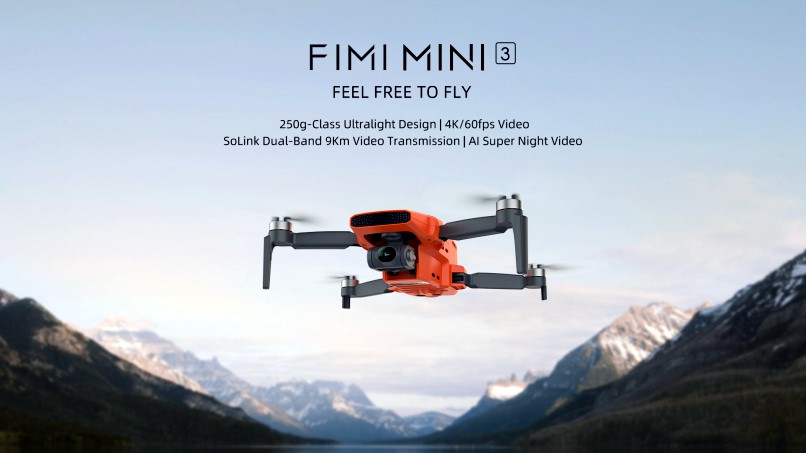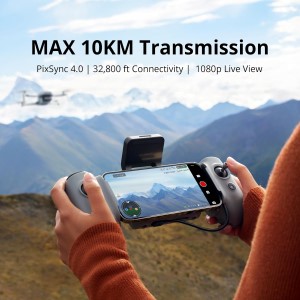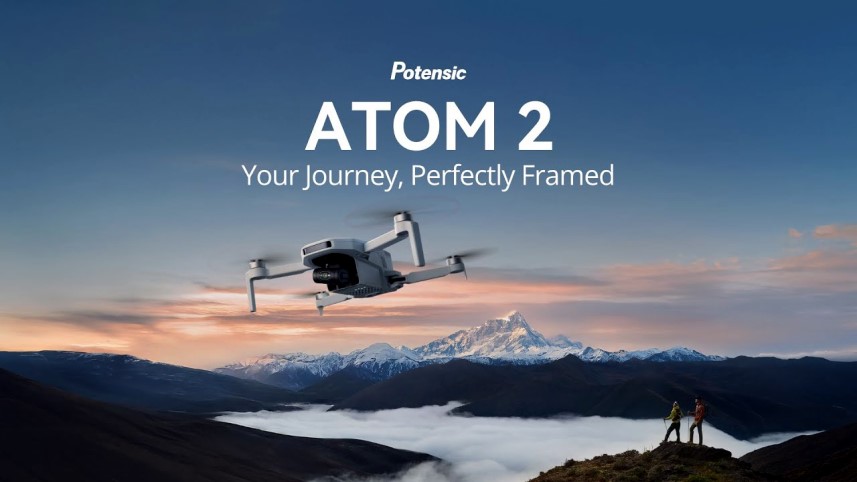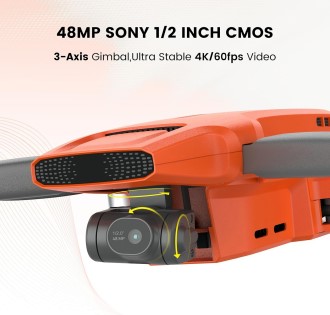
Fimi Mini 3 vs Potensic Atom 2: A 2025 Comprehensive Drone Comparison
In the rapidly growing world of consumer drones, finding the perfect balance between features, performance, and price is essential for enthusiasts and beginners alike. Two drones that have recently gained significant attention are the Fimi Mini 3 and the Potensic Atom 2. Both are compact, feature-rich, and designed for users who want a high-quality flying experience without breaking the bank. This article provides a detailed comparison of these two drones, covering everything from design and camera capabilities to flight performance and user experience, to help you make an informed decision.
1. Introduction
The Fimi Mini 3 and Potensic Atom 2 are both sub-250g drones, making them ideal for hobbyists and casual users who want to avoid the hassle of registration in many regions. They offer advanced features like 4K video recording, intelligent flight modes, and foldable designs for easy portability. However, there are key differences in their camera quality, flight performance, and overall user experience that could sway your decision. Let’s dive into the details.

2. Design and Build Quality
Both drones prioritize portability and durability, catering to users who need a drone that’s easy to carry and robust enough for regular use.
-
Fimi Mini 3: This drone features a sleek, professional design with high-quality materials that give it a premium feel. It weighs just 249g and folds down to a compact size (145mm x 85mm x 65mm when folded), making it highly portable. Its build quality is solid, with a focus on durability for regular use (Fimi Mini 3 Product Page).
-
Potensic Atom 2: Similarly, the Potensic Atom 2 is lightweight at 249g and foldable (88mm x 143mm x 58mm when folded). It has a robust build with a focus on durability, ensuring it can handle the wear and tear of frequent flights. Both drones come with a carrying case, enhancing their portability for on-the-go adventures (Potensic Atom 2 Specifications).
Verdict: Both drones are well-built and portable, with no clear winner in this category. Your choice may come down to aesthetics, as both have slightly different designs.

3. Camera and Imaging Capabilities
The camera is often the most important feature for drone buyers, and both models deliver impressive performance.
-
Fimi Mini 3: Equipped with a Sony 1/2-inch 48MP CMOS sensor, the Fimi Mini 3 can record 4K video at 60fps and capture 48MP photos. It also supports 12X digital zoom and features like AI Night Video for low-light shooting. This makes it a strong contender for users who prioritize smooth, high-frame-rate video (Fimi Mini 3 Product Page).
-
Potensic Atom 2: The Potensic Atom 2 also features a 1/2-inch CMOS sensor but tops out at 4K video at 30fps, with 48MP photo capabilities. It supports HDR video and has a maximum bitrate of 80Mbps for high-quality footage. While its video frame rate is lower than the Fimi Mini 3, it still delivers excellent image quality (Potensic Atom 2 Specifications).
|
Feature |
||
|---|---|---|
|
Sensor |
Sony 1/2-inch 48MP CMOS |
1/2-inch CMOS |
|
Video Resolution |
4K @ 60fps |
4K @ 30fps |
|
Photo Resolution |
48MP |
48MP |
|
Digital Zoom |
12X |
4X |
|
Low-Light Performance |
AI Night Video |
Night Shooting Mode |
|
HDR Support |
Yes |
Yes (4K HDR) |
Verdict: The Fimi Mini 3 has an edge in video quality due to its higher frame rate (4K/60fps vs. 4K/30fps), making it better for smoother footage. However, both drones are capable of producing high-quality images and videos.
4. Flight Performance
Flight performance is crucial for both casual flyers and content creators.
-
Fimi Mini 3: This drone can reach speeds of up to 18 m/s (64.8 km/h), slightly faster than the Potensic Atom 2. It has a maximum flight time of around 30 minutes under ideal conditions, though real-world usage may yield closer to 20-25 minutes. Its transmission range is an impressive 9KM, allowing for long-distance flying (Fimi Mini 3 Review).
-
Potensic Atom 2: With a maximum speed of 16 m/s (57.6 km/h), the Potensic Atom 2 is slightly slower but still agile. It also offers up to 30 minutes of flight time, though real-world conditions may reduce this to 20-25 minutes. Its transmission range is longer at 10KM, giving it an advantage for long-range flights (Potensic Atom 2 Review).
|
Feature |
||
|---|---|---|
|
Max Speed |
18 m/s (64.8 km/h) |
16 m/s (57.6 km/h) |
|
Transmission Range |
9KM |
10KM |
|
Flight Time (Ideal) |
~30 minutes |
~30 minutes |
|
Real-World Flight Time |
~20-25 minutes |
~20-25 minutes |
|
Wind Resistance |
Level 5 (up to 24 mph) |
Level 5 (up to 24 mph) |
Verdict: The Fimi Mini 3 is faster, but the Potensic Atom 2 has a longer transmission range. Both have similar flight times, so your choice may depend on whether speed or range is more important to you.
5. Intelligent Features
Intelligent flight modes add versatility and creativity to your drone experience.
-
Fimi Mini 3: Offers AI tracking, night mode, and flight planning, allowing for complex shots like follow-me modes and custom flight paths. It also supports vertical shooting, which is great for social media content (Fimi Mini 3 Review).
-
Potensic Atom 2: Includes AI tracking (with modes like Spotlight, Follow, and Parallel), vertical shooting, and cruise control for smoother flight. It also supports advanced features like Dolly Zoom and Pull-away, making it highly versatile for creative shots (Potensic Atom 2 Review).
Verdict: Both drones offer a robust set of intelligent features, but the Potensic Atom 2’s additional modes like Dolly Zoom give it a slight edge for creative videography.

6. User Interface and App
The user interface can significantly impact your flying experience, especially for beginners.
-
Fimi Mini 3: Uses the FIMI PALM app, which is functional but may feel less intuitive compared to other drone apps. It allows for live video feed, flight telemetry, and camera adjustments but lacks some of the polish found in more advanced apps (Fimi Mini 3 User Reviews).
-
Potensic Atom 2: Utilizes the Potensic Eve app, which is praised for its user-friendly design and comprehensive features. It offers a smooth interface similar to DJI’s Fly app, making it easier for new pilots to navigate (Potensic Atom 2 Review).
Verdict: The Potensic Atom 2’s app is more user-friendly and intuitive, making it a better choice for beginners or those who prefer a seamless flying experience.
7. Battery and Flight Time
Battery life is a key consideration for any drone.
-
Fimi Mini 3: Comes with a single battery offering up to 30 minutes of flight time (real-world usage may be closer to 20-25 minutes). Additional batteries can be purchased separately (Fimi Mini 3 Review).
-
Potensic Atom 2: Also offers up to 30 minutes of flight time per battery, with real-world usage around 20-25 minutes. It’s available in a bundle with three batteries and a multi-charger, which is convenient for extended flying sessions (Potensic Atom 2 Specifications).
Verdict: Both drones have similar flight times, but the Potensic Atom 2’s bundle option makes it more convenient for users who want to fly longer without frequent recharging.
8. Price and Value
Pricing is often a deciding factor for many buyers.
-
Fimi Mini 3: Priced around $299 for the standard kit, which includes one battery and basic accessories.*
-
Potensic Atom 2: Slightly more expensive at $329.99 for the standard kit, but it offers a bundle option with three batteries and a carrying case for $449.99, providing better value for users who want extended flight time.*
|
Feature |
||
|---|---|---|
|
Standard Kit Price |
~$299* | ~$329.99* |
|
Bundle Price |
N/A |
~$449.99* (3 batteries, case) |
|
Value Proposition |
Budget-friendly |
Better for extended use |
Verdict: The Fimi Mini 3 is more affordable upfront, but the Potensic Atom 2’s bundle option offers better long-term value, especially for users who plan to fly frequently.
(*Prices as of this article 5-17-2025)
9. Customer Support and Reliability
Reliability and customer support can make or break your drone experience.
-
Fimi Mini 3: Has received mixed reviews regarding customer support, with some users reporting difficulties in getting assistance and issues with product reliability, such as shorter-than-advertised flight times (Fimi Mini 3 User Feedback).
-
Potensic Atom 2: Has been praised for its responsive customer support and overall reliability. Users have reported fewer issues with the drone’s performance and build quality (Potensic Atom 2 Review).
Verdict: The Potensic Atom 2 is the clear winner in terms of customer support and reliability, making it a safer choice for buyers concerned about long-term satisfaction.

10. Conclusion
Both the Fimi Mini 3 and Potensic Atom 2 are excellent choices for beginners and hobbyists looking for a feature-rich, portable drone. The Fimi Mini 3 stands out with its superior camera capabilities (4K/60fps video) and faster flight speed, making it ideal for users who prioritize video quality and agility. On the other hand, the Potensic Atom 2 offers a longer transmission range (10KM), better customer support, and a more user-friendly app, making it a more reliable and beginner-friendly option.
Who Should Buy Each?
-
Fimi Mini 3: Best for users who prioritize high-frame-rate video and don’t mind potential customer support challenges. It’s a great choice for those on a tighter budget who want premium video quality.
-
Potensic Atom 2: Ideal for those who value reliability, ease of use, and a longer transmission range, especially if they opt for the bundle with extra batteries. It’s perfect for beginners and users who want a hassle-free experience.
Ultimately, your choice will depend on your specific needs—whether it’s superior video quality, longer range, or better support and reliability. Both drones are strong contenders in the sub-250g market, offering excellent value for their price points.
** Click Here to Order Fimi Mini 3 **
** Click Here to Order Potensic Atom 2 **



